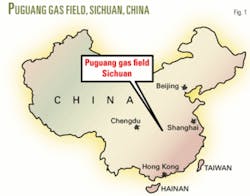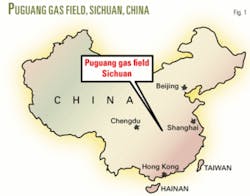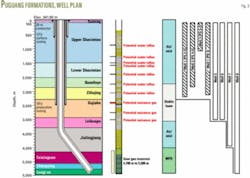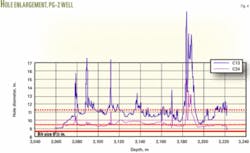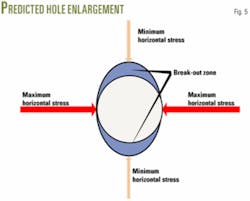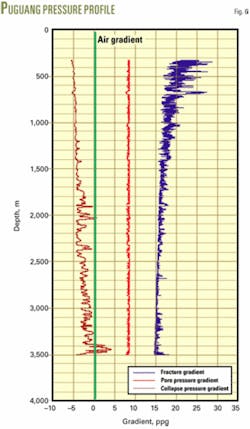Sinopec conducted 9 months of managed-pressure drilling (MPD) operations in hard rock and sour-gas formations in the Puguang field, Sichuan province, southwestern China. Initially envisioned with only two wells, Sinopec commissioned the project to determine whether percussion air-drilling technology could provide rate-of-penetration (ROP) benefits.
Because the feasibility report determined that wellbore stability could be an issue, a certain amount of project risk was involved. In addition, the main reservoir is sour and potential sweet-gas secondary zones are above it.
Conventional 5,500-m wells were being drilled and completed in about 350 days. The first air-drilled well was spudded in March 2006 and immediate benefits were realized, saving more than 60 days in the main 311-m section. Four subsequent wells have improved ROP by 94%, eliminating an additional 60 days from the drilling curve. Wells are currently being drilled in 240 days.
As the project progresses, Sinopec will drill the sour-gas reservoir near-balanced, using MPD techniques. The stepped approach should improve ROP performance and reduce overall well times.
Weatherford is the only western service company working in the Puguang field and lessons learned during this project have significantly affected MPD and percussion air drilling in China. Enhanced engineering reviews, better implementation of procedures, management-of-change processes, improved client awareness, and closer cooperation between operator and service provider are enabling successful execution of remote MPD projects in China and elsewhere in Asia-Pacific.
This first article in a two-part series describes the drilling challenges in the Puguang field, drilling-failure analysis, risk assessment, and the project management road map.
The conclusion, next week, discusses the optimized well design and Sinopec’s experiences with percussion drilling with compressed air and foam, used in both top-hole and nuisance-gas formations. The concluding article also covers the MPD system design and introduces plans for near-balanced operations in the sour-gas reservoir.
Field description
The giant Puguang gas field was discovered in 2003, in the Eastern Sichuan fold-thrust belt, in the mature Sichuan basin of southwestern China. A structural-stratigraphic trap, which is closed by lateral depositional change and dip closure, defines the field.
After drilling four appraisal wells, Sinopec assessed Puguang as one of China’s largest gas fields, with estimated reserves of 4 tcf of gas in the lower-Triassic Feixianguan limestone. The rocks consist primarily of mudstones, siltstone, and shale sequences above the productive carbonate reef zone.
Following the four discovery and appraisal wells, a first-phase development program was approved in 2005 to exploit the field. Sinopec now plans to drill and complete 54 wells from 17 pads by 2009. By early 2007, about 10 wells had been drilled from seven pads. Development of this field is considered strategic to the development of the country (Fig. 1).
Drilling
The deep, sour wells at Puguang are some of the country’s most challenging and difficult to plan and execute. The first well (PG 1) was spudded in November 2001 and took 630 days to drill and complete. Subsequent wells (PG 2, 3, and 4) averaged 357 days to drill and complete due to numerous drilling difficulties. In addition to low ROPs, problems included the nonproductive time (NPT) associated with drillstring failure, out-of-gauge wellbores, nuisance gas, stuck pipe associated with hole instability, fluid losses across fractures, and use of highly overbalanced fluid systems.
The long drilling times were a direct result of multiple subsurface factors:
1. Hard formations. For hard-rock drilling, rocks encountered in the Puguang wells rank among the hardest, with unconfined compressive strengths ranging from 20,000 psia (140 MPa) through the Jurassic section and 29,000 psia (200 MPa) through the Triassic section (Fig. 2). Mudstone and siltstone are the main lithologies above the main limestone reservoir.
2. Wellbore instability. Puguang wells have issues with both shale and hole stability. Due to shale stability, the wells require normal weight muds with inhibitors to successfully control reactive shales and clay. Because of clay hydration in the rock matrix, however, the strength of the Triassic formations decreases significantly with the absorption of water.
Four mudstone and shale formations contribute to hole instability (Fig 3):
- Chongqing group (Jc). The clay minerals of this group consist mainly of interbedded montmorillonite (up to 75%) and the rock is subject to severe hydration and subsequent clay expansion. Most of the Chongqing group is normally pressured and consists of a destabilized, ductile, soft mudstone with relatively high cation-exchange capacity (CEC) values and hydrate expansion ratios. The destabilized mud shale exhibits high mud-making and swelling, and results in some hole enlargement.
- Flowing well group (Jt). This group has moderate shale content, gradually decreasing in montmorillonite and increasing in kaolinite and chlorite content. It is an under-compacted formation, laminated, fractured in places, and unconsolidated. These characteristics make this group a highly unstable zone.
- Leping group (P2). This group contains up to 55% montmorillonite and only moderate kaolinite-chlorite content.
- Liangshan group (P11). Severe hole collapse has been observed in this group above 4,000-m depth. The group is comprised of montmorillonite (20%) interbedded with kaolinite and chlorite. The Liangshan group is reported to have a strong hydration tendency, which results in unstable conditions in the wellbore.
In addition to the extremely water-sensitive clays, hole breakout caused by tectonic stresses creates a degree of hole enlargement.
The Puguang gas field developed across a fault-related fold zone in the Jialinjian Horizon 4 formation of the Lower Triassic system.
Based on the geomechanics and fault distribution, Sinopec concluded that the Jurassic and Triassic formations are controlled by a slip fault. The maximum principal stresses are west-east compressional stresses, which are greater than the overburden stress. It has already been confirmed that, as a result of the tectonic stress, the maximum horizontal stress causes formation breakout in the hole in the direction of the minimum horizontal stress.
We do not expect the hole diameter in the direction of the maximum horizontal stress to decrease; so there is no indication of hole pinching, but there is hole enlargement up to 2 in. in a north-south orientation. Based on the caliper log data of PG-2 (Fig. 4), the azimuth of the maximum horizontal in-situ stress is about NE 85°. This effect is likely to result in an egg-shaped hole during drilling. It cannot be mitigated by applying pressure inside the hole and is likely to have a significant effect on hole cleaning and annular velocities (Fig. 5).
3. Nuisance gas. Many gas zones must be drilled before reaching the primary reservoir. The sections drilled with air are all identified as non-productive zones. Among the zones is the Xujiahe formation, which has some tight gas sandstones. This formation is part of the zone between the surface casing, set at 700 m, and the 103⁄4-in. casing setting depth, at 3,600 m.
In addition to potential drilling delays, the gas poses a well control hazard because of the shallow setting depth of the surface casing shoe. The 13 3/8-in. surface casing is set between 600-700 m. If a significant gas-producing zone is encountered in the air-drilled sections above 3,600 m, well control cannot be maintained. Concern for fracturing the formations at the shoe preclude the feasibility of closing in the well (Fig. 6).
4. Lost circulation. In the upper formations of the Shaximiao, lost circulation was very common. Puguang wells typically encountered lost circulation in the 89-154 m interval, with total losses of 224 cu m and average fluid losses of 1.3-8.0 cu m/hr. Adding lost-circulation material was the most common response, limiting fluid loss.
5. Hydrogen sulfide (H2S), carbon dioxide (CO2). The reservoir is highly sour (15% H2S) and corrosive (8% CO2). Table 1 shows the gas composition in the reservoir.
6. Water influx. During the candidate-evaluation phase, the wellbore-stability study concluded that water influx could be a major issue in the Shaximiao series between 1,500 and 2,000 m. Five additional zones above 1,500 m were also predicted to be potential water-influx zones.
Drilling failure analysis, risk assessment
Numerous drilling problems and long well durations during the discovery and appraisal well program put the economical feasibility of the field in doubt. This had to be resolved in order to plan a successful development program.
Sinopec commissioned a feasibility study to determine the appropriateness of applying MPD principles to achieve performance objectives. The team used a systematic, in-house approach, using a proven project management road map, to analyze drilling issues in the Puguang field (Fig 7).
Project management road map
Weatherford assesses MPD complexity through an analysis that determines a risk-assessment value. The risk matrix is designed to reduce operations engineering turnaround time and costs. It provides a way to capture and disseminate global learnings, reduces client learning curves, and provides a means for technical education. The matrix also provides a system for effective management change and identifying quality, health, safety, and environmental (QHSE) hazards.
One calculates the risk value using factors such as IADC’s well-classification matrix, reservoir and productivity characteristics, technical and equipment issues, the operator’s experience level, and environmental factors.
Puguang drilling above the reservoir has a risk level of 3.7, which is considered low. Medium-level concerns were related to the remoteness of the area and the client’s inexperience with MPD technology and methods (Fig. 8).
Reservoir drilling with MPD methods has the highest known risk value and has been scheduled further into the program once MPD competency has been developed above the reservoir.
The team analyzed the drilling performance from previous, conventionally drilled wells and concluded that:
- With ultrahard rock and highly overbalanced fluid systems being the primary contributor to long drilling times (average ROP 1 to 2 m/hr), the Puguang field was an obvious candidate for MPD at first glance. The hard-rock drilling created excessive drilling-string vibration, causing severe damage and premature string failures. Numerous fishing jobs related to parted pipe occurred during the four appraisal wells.
Additionally, significant delays and costs were incurred as a result of poor bit performance. About 128 bits/well were used to reach total depth (TD). There were problems related to hole collapse in the Qianfoya formation, causing stuck pipe and logging tools. Finally, lost circulation in the upper Shaximiao created additional lost time, incurring losses. - Because of low ROP, long open-hole drilling sections (more than 3,000 m), water-sensitive formations, and the drilling problems encountered with conventional techniques, we determined the Puguang wells to be excellent candidates for MPD optimization. Suggested MPD techniques included using air, mist, or foam down to the reservoir. We also recognized percussion drilling using air hammers as one of the main technologies for increasing ROP.
- The advantages of using air as a circulating fluid are substantial. In comparison with mud rates, the ROPs are significantly higher, which reduces drilling time. In addition, significantly fewer bits are used when drilling with air. Wellbore problems such as lost circulation and sloughing shales are virtually eliminated, and air drilling allows the use of air percussion hammers, which not only improves drilling rates but also contributes to drilling a true vertical hole.
Concerns
The main areas of concern with using air or percussion drilling were: well control in high-pressure zones; downhole fires; wellbore stability; water flows; and deviation control.
Well control
Given the reduced-annular-pressure environment in the wellbore, the ability to cope with any excess formation pressures during drilling is very limited. Borehole stability issues associated with high-pressure zones can rapidly escalate into severe drilling problems and possibly stuck pipe. Because the offset wells were drilled with relatively high mud weights, only limited pore pressure and formation stability data were available at the feasibility study phase.
With air-drilling operations, the borehole pressure is reduced to virtually zero. The implication is that any formations that are porous and permeable will produce fluids and gases. Any formations that are prone to collapse under pressure will collapse.
Formation pressures at the TD of the 12 3/8-in. section at 3,600 m were potentially as high as 5,200 psi (35 MPa), while the fracture pressure at the 13 3/8-in. shoe at 700 m is only about 2,000 psi (13.8 MPa). These figures imply that, if a substantial gas flow were encountered from near TD, the well could not be controlled. Well-control procedures for air drilling reflect this situation.
Downhole fires
If gas concentrations remain less than 5%, no downhole fires will occur. Furthermore, keeping the temperature in the well from increasing reduces the potential for downhole fires. With the lowest volume of air being pumped in the 12 3/8-in. section as 3,000 scfm (85 cu m/min), the volume of gas that can be controlled is 4% × 85 cu m/min = 3.4 cu m/min, or 120 scfm, or 172,800 scfd (4,900 cu m/day). No formations at 700-3,600 m have been tested to these high rates.
Wellbore stability
It was highly probable that borehole stability issues could prevent performance drilling with air, particularly if water was present. In addition, there was a concern about tectonic stresses creating an enlarged, egg-shaped wellbore, resulting in an increased requirement of air to maintain adequate hole cleaning.
Water flows
A small influx of water into a dry air-drilled hole is often followed by the creation of so-called “mud rings,” which can cause the annulus to pack off. Any packoff or mud ring increases the potential for a downhole fire. Furthermore, any water flow risks potential shale instability as a result of the water-wetting of the claystones.
Deviation control
Although hammer drilling is extremely effective at reducing deviation because of the low weight on bit and low speed, close attention to deviation control is still required. This is especially important in pad drilling of multiple wells to avoid collisions.
Project management
The remote location of this project presented another set of concerns. QHSE issues regarding well control, avian flu, close proximity of civilian population and housing to the rig site, accommodation, hygiene, and medical care were all required close cooperation between Sinopec and Weatherford.
Although all these concerns were generally solved to mutual satisfaction, questions about rig-site decision making and well-control philosophy still remain. They are continually being addressed and as confidence develops on both sides, trust is beginning to build.
Bibliography
Ma, Y., et al.: “The Puguang Gas Field-New Giant Discovery in the Mature Sichuan Basin, SW China,” Abstracts Volume, Annual AAPG Convention, Houston, 2006, v. 15, p. 67.
The authors
Chen Shen ([email protected]) is chief engineer of E&P department for China Petroleum & Chemical Corp. (Sinopec) based in Beijing. He has 24 years of petroleum industry experience. Shen holds a PhD degree in petroleum engineering from The University Petroleum China. He is a member of SPE.
Xinming Niu ([email protected]) is vice-director of technology division of the E&P department for China Petroleum & Chemical Corp. (Sinopec) based in Beijing. He has 25 years of petroleum industry experience. Niu holds a BSc degree in petroleum engineering from South West Petroleum University, China. He is a member of SPE.
Steve Nas ([email protected]) is regional engineering manager for Weatherford’s Asia Pacific controlled pressure drilling, Singapore. He was engineering manager for Leading Edge Advantage, Aberdeen, before joining Weatherford in 2004. Nas has 30 years of industry experience and holds an MS in drilling engineering from The Robert Gordon University, Aberdeen. He is a member of SPE, IADC, and ICOTA, and was SPE distinguished lecturer on Underbalanced Drilling Technology from 1999 to 2000.
Calvin Holt ([email protected]) is the controlled pressure drilling & testing region manager for Weatherford Asia Pacific based in Singapore. He has been involved in managed pressure and underbalanced operations for more than 5 years. Prior to Weatherford, he worked for Western Atlas and Schlumberger in field engineering roles. He holds a BSc in petroleum engineering from Montana Tech and an MBA from the University of Strathclyde. Holt is a member of SPE and has authored numerous SPE and IADC papers.
